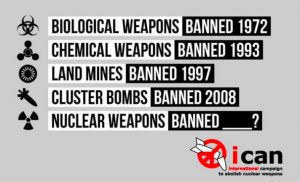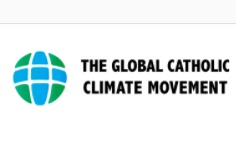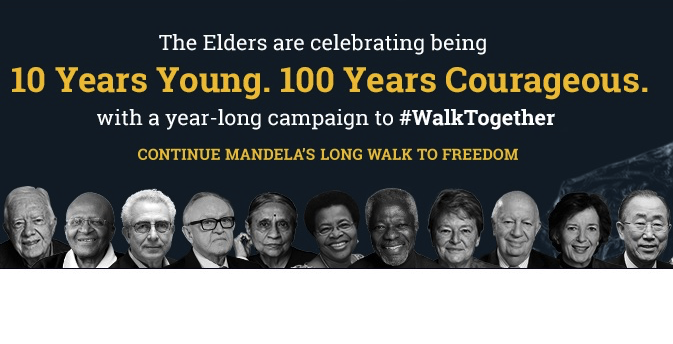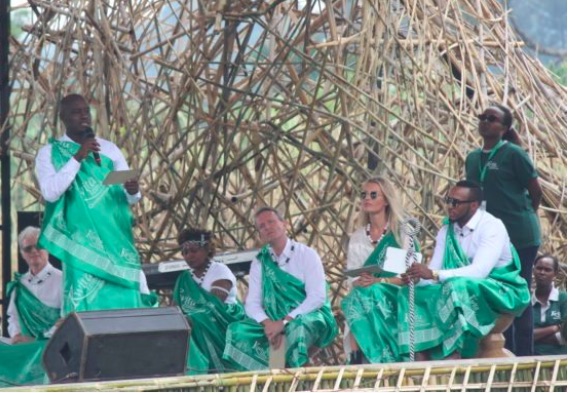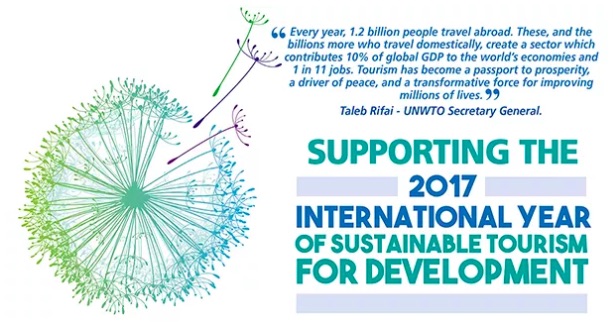DISARMAMENT & SECURITY .
An article from UNFOLD ZERO
Governments have gathered at the United Nations in New York this month (October) to discuss and adopt nuclear disarmament proposals, including a draft resolution to set the dates and mandate for the first ever UN High Level Conference on Nuclear Disarmament (UNHLC), scheduled for 2018. A coalition of international civil society organisations and networks used this occasion to meet on Oct 11-12 in a ‘virtual’ conference to discuss action plans and strategies to ensure success of the UNHLC.
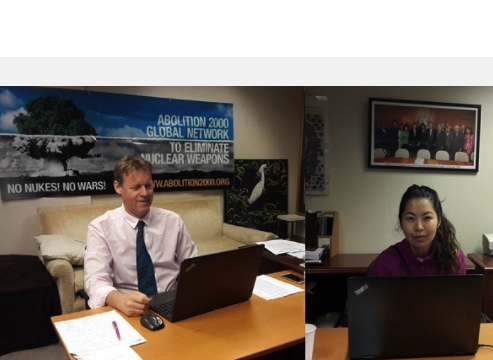
Alyn Ware and Marzhan Nurzhan at the hub of the virtual conference – the Global Security Institute office next to the United Nations in New York
The conference involved a series of webinar sessions with civil society representatives participating from around the world through their home/office computers, laptops, cell phones and smart phones.
It was convened by the Basel Peace Office, Global Security Institute, Parliamentarians for Nuclear Non-proliferation and Disarmament, UNFOLD ZERO and the Abolition 2000 working group on the 2018 UN High-Level Conference.
Why the UN High-Level Conference
‘We are at a cross-roads of increased nuclear dangers and alternative realities,’ said Alyn Ware, convener of the conference.
‘On the one hand regional conflicts and tensions, such as in North-East Asia, and between Russia and the West, are increasing the reliance on nuclear weapons and the risk of a nuclear catastrophe by accident, miscalculation or even intent. On the other hand, we have a majority of UN member states – all non-nuclear countries – adopting a Treaty on the Prohibition of Nuclear Weapons (TPNW).’
‘These two communities are living in different realities, and the divide between them is increasing. The 2018 UN High-Level Conference provides an opportunity to bridge the communities, and make progress on both nuclear-risk reduction and disarmament measures.’
‘The UN Conference can also bridge the different multilateral processes and forums such as the Non-Proliferation Treaty Review process, UN General Assembly (through which the TPNW was negotiated), UN Security Council and the Conference on Disarmament.’
Most importantly, the UN High-Level Conference on Nuclear Disarmament, which will take place in May 2018, can elevate the political, media and public attention to nuclear disarmament in all UN member states, and establish a global expectation of a concrete outcome or outcomes.
We have had considerable success with similar high-level UN conferences on Sustainable Development (2015) which adopted the 17 Sustainable Development Goals; Climate Change (2016) which adopted the Paris Agreement; Refugees and Migrants (2016) which achieved the New York Declaration; and Oceans (2017) which adopted the 14-point action plan Our Ocean Our Future.
But these all required cooperative action by civil society to push their governments into concrete action. The civil society virtual conference on Oct 11-12 is one of the many efforts to build cooperation and action to ensure the 2018 UNHLC on Nuclear Disarmament is also a success.
The Oct 11-12 conference included six sessions focusing on:
* Politics of current nuclear weapons policies. Nuclear risk-reduction and disarmament initiatives;
* Value of UN High-Level Conferences/Summits. Learning from UN summits on other issues (climate change, sustainable development);
* Visions for the 2018 UNHLC. What are possible outcomes which we should be promoting;
* Engaging governments and preparatory work. How to ensure governments will attend at the highest level and take action in good faith on concrete nuclear disarmament measures;
* Summarizing and packaging the politics and opportunities of the UNHLC; Making it understandable to public.
* Engaging key constituencies and building the campaign. Involvement of parliamentarians, mayors, youth, religious leaders/communities, academics… Public events and promotion.
The conference built on a series of consultation events and meetings conducted by the co-sponsoring organisations in key capitals, UN centres and inter-parliamentary assemblies over the past year. Input from these consultations provided the basis for a food-for-thought paper which explores the optimum agenda and approach of the 2018 UNHLC to ensure success.
(Article continued in right column)
Question for this article:
A UN High-Level Conference on Nuclear Disarmament: Distraction or progress?
(Article continued from left column)
Key themes and approaches;
There were a number of key themes and approaches to the UNHLC discussed during the Oct 11-12 conference. These included:
Civil society should call on all governments to attend the UNHLC at the highest level. This call can be made to governments of nuclear-armed, allied and non-nuclear countries alike;
Governments already supporting the UNHLC could do joint calls on all other governments to attend the UNHLC at the highest level. CELAC (organisation of Latin American and Caribbean governments) is an obvious possibility given their initial push for the high-level conference;
The UNHLC should provide a space for all countries to participate, and for a range of initiatives to be advanced, including the Treaty on the Prohibition of Nuclear Weapons, lowering the salience of nuclear weapons, de-alerting, no-first-use, ending nuclear tests, negative security assurances, nuclear stockpile reductions, establishment of nuclear-weapon-free zones and developing a framework for global elimination;
A goal for the Treaty on the Prohibition of Nuclear Weapons could be to obtain 100 signatures by the close of the UNHLC (a number of governments could choose to sign at the UNHLC);
A ‘gift-basket‘ approach could be useful, as it was in the Nuclear Security Summits. This would involve the announcement and/or adoption of a range of measures and initiatives by groups of States, without requiring unanimity of all at the UNHLC;
The UNHLC could recommend UN Security Council action on a number of initiatives, such as that any testing of nuclear weapons would be a threat to peace and security, and that any use of weapons of mass destruction would be a crime against humanity and a threat to peace and security;
In order to move nuclear-armed and allied States to agree to eliminate the role of nuclear weapons in their security doctrines, it will probably be necessary to advance common security approaches for addressing security situations in which they currently believe that nuclear deterrence is necessary. Common security approaches (diplomacy, mediation, arbitration, adjudicaton…) and mechanisms (United Nations, International Court of Justice, International Criminal Court, Organisation for Security and Cooperation in Europe…) are already available but need promoting;
Parliamentarians have a key role to play in moving governments to attend the UNHLC and to commit to concrete outcomes. Civil society should work with parliamentarians to raise questions and advance debates/motions about the 2018 UNHLC in their parliaments;
Civil society should also contact their government officials (foreign ministries and UN ambassadors) directly. PNND and GSI maintains (and will expand) a database of government officials from key countries, plus background on ‘entry points’ (relevant UN resolutions they have supported, and IPU resolutions their parliaments have supported) in order to assist civil society advocates.
Actions and commitments arising from, or announced at, the Oct 11-12 conference include:
1. Abolition 2000 has established a working group on the 2018 UNHLC which is open to anyone to join.This will provide a basis for building cooperation amongst civil society on actions and plans for the 2018 UNHLC;
2. PNND is organising an event at the Inter-Parliamentary Union Assembly in St Petersburg to promote the ban treaty, nuclear-risk reduction measures and the 2018 UNHLC;
3. The Abolition 2000 Youth Network and PNND are organising an international youth conference on the 2018 UNHLC. The youth conference will take place in Prague, Czech Republic on Nov 28-29, 2017;
4. UNFOLD ZERO maintains a webpage dedicated to the 2018 UN High-Level Conference. This includes all relevant documents, reports and actions;
5. The Abolition 2000 Youth Network is planning a global Reach HIGH for a nuclear-weapon-free world video, which will involve youth around the world lifting a peace sign high and then passing it to youth video video connection (more detailed explanation to follow). The final video will be shown during the Prep Com for the 2018 UNHLC in New York on March 28;
6. PNND has just produced a Parliamentary Action Plan for a Nuclear-Weapon-Free World which includes parliamentary actions to support the 2018 UNHLC;
7. UNFOLD ZERO and PNND will produce a civil society action guide for the 2018 UNHLC;
8. PNND, Mayors for Peace and Religions for Peace will present the joint appeal ‘A Nuclear-Weapon-Free World: Our Common Good‘ to the President of the 2018 UNHLC and participating governments at the UNHLC Preparatory Meeting in New York on March 28. Additional mayors, parliamentarians and religious leaders can be invited to endorse before March 25, 2018.
9. World Future Council, PNND, Basel Peace Office and the Abolition 2000 working group on the 2018 UNHLC are planning an action ‘Count the nuclear weapons budget‘ in New York over the three days of the UNHLC. Celebrities, youth and peace activists will count 1 million mock $1 million notes = $1 trillion dollars (the nuclear weapons budget for the next decade).


